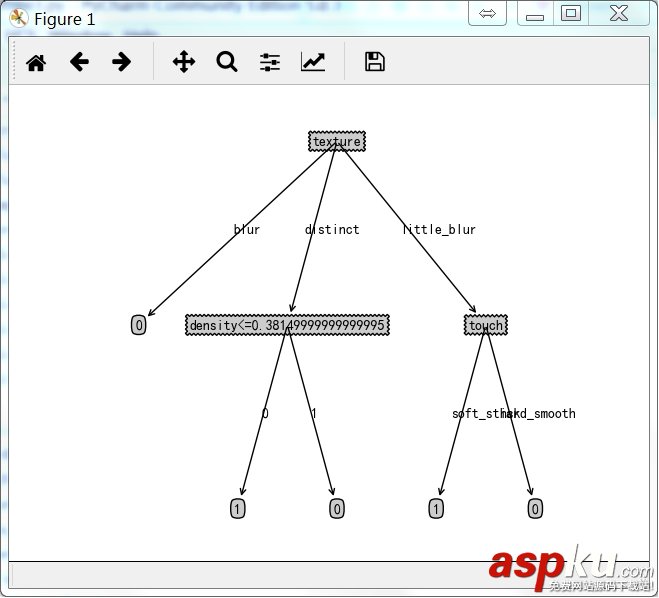實例如下:
# -*- coding:utf-8 -*-from numpy import *import numpy as npimport pandas as pdfrom math import logimport operator#計算數據集的香農熵def calcShannonEnt(dataSet): numEntries=len(dataSet) labelCounts={} #給所有可能分類創建字典 for featVec in dataSet: currentLabel=featVec[-1] if currentLabel not in labelCounts.keys(): labelCounts[currentLabel]=0 labelCounts[currentLabel]+=1 shannonEnt=0.0 #以2為底數計算香農熵 for key in labelCounts: prob = float(labelCounts[key])/numEntries shannonEnt-=prob*log(prob,2) return shannonEnt#對離散變量劃分數據集,取出該特征取值為value的所有樣本def splitDataSet(dataSet,axis,value): retDataSet=[] for featVec in dataSet: if featVec[axis]==value: reducedFeatVec=featVec[:axis] reducedFeatVec.extend(featVec[axis+1:]) retDataSet.append(reducedFeatVec) return retDataSet#對連續變量劃分數據集,direction規定劃分的方向,#決定是劃分出小于value的數據樣本還是大于value的數據樣本集def splitContinuousDataSet(dataSet,axis,value,direction): retDataSet=[] for featVec in dataSet: if direction==0: if featVec[axis]>value: reducedFeatVec=featVec[:axis] reducedFeatVec.extend(featVec[axis+1:]) retDataSet.append(reducedFeatVec) else: if featVec[axis]<=value: reducedFeatVec=featVec[:axis] reducedFeatVec.extend(featVec[axis+1:]) retDataSet.append(reducedFeatVec) return retDataSet#選擇最好的數據集劃分方式def chooseBestFeatureToSplit(dataSet,labels): numFeatures=len(dataSet[0])-1 baseEntropy=calcShannonEnt(dataSet) bestInfoGain=0.0 bestFeature=-1 bestSplitDict={} for i in range(numFeatures): featList=[example[i] for example in dataSet] #對連續型特征進行處理 if type(featList[0]).__name__=='float' or type(featList[0]).__name__=='int': #產生n-1個候選劃分點 sortfeatList=sorted(featList) splitList=[] for j in range(len(sortfeatList)-1): splitList.append((sortfeatList[j]+sortfeatList[j+1])/2.0) bestSplitEntropy=10000 slen=len(splitList) #求用第j個候選劃分點劃分時,得到的信息熵,并記錄最佳劃分點 for j in range(slen): value=splitList[j] newEntropy=0.0 subDataSet0=splitContinuousDataSet(dataSet,i,value,0) subDataSet1=splitContinuousDataSet(dataSet,i,value,1) prob0=len(subDataSet0)/float(len(dataSet)) newEntropy+=prob0*calcShannonEnt(subDataSet0) prob1=len(subDataSet1)/float(len(dataSet)) newEntropy+=prob1*calcShannonEnt(subDataSet1) if newEntropy<bestSplitEntropy: bestSplitEntropy=newEntropy bestSplit=j #用字典記錄當前特征的最佳劃分點 bestSplitDict[labels[i]]=splitList[bestSplit] infoGain=baseEntropy-bestSplitEntropy #對離散型特征進行處理 else: uniqueVals=set(featList) newEntropy=0.0 #計算該特征下每種劃分的信息熵 for value in uniqueVals: subDataSet=splitDataSet(dataSet,i,value) prob=len(subDataSet)/float(len(dataSet)) newEntropy+=prob*calcShannonEnt(subDataSet) infoGain=baseEntropy-newEntropy if infoGain>bestInfoGain: bestInfoGain=infoGain bestFeature=i #若當前節點的最佳劃分特征為連續特征,則將其以之前記錄的劃分點為界進行二值化處理 #即是否小于等于bestSplitValue if type(dataSet[0][bestFeature]).__name__=='float' or type(dataSet[0][bestFeature]).__name__=='int': bestSplitValue=bestSplitDict[labels[bestFeature]] labels[bestFeature]=labels[bestFeature]+'<='+str(bestSplitValue) for i in range(shape(dataSet)[0]): if dataSet[i][bestFeature]<=bestSplitValue: dataSet[i][bestFeature]=1 else: dataSet[i][bestFeature]=0 return bestFeature#特征若已經劃分完,節點下的樣本還沒有統一取值,則需要進行投票def majorityCnt(classList): classCount={} for vote in classList: if vote not in classCount.keys(): classCount[vote]=0 classCount[vote]+=1 return max(classCount)#主程序,遞歸產生決策樹def createTree(dataSet,labels,data_full,labels_full): classList=[example[-1] for example in dataSet] if classList.count(classList[0])==len(classList): return classList[0] if len(dataSet[0])==1: return majorityCnt(classList) bestFeat=chooseBestFeatureToSplit(dataSet,labels) bestFeatLabel=labels[bestFeat] myTree={bestFeatLabel:{}} featValues=[example[bestFeat] for example in dataSet] uniqueVals=set(featValues) if type(dataSet[0][bestFeat]).__name__=='str': currentlabel=labels_full.index(labels[bestFeat]) featValuesFull=[example[currentlabel] for example in data_full] uniqueValsFull=set(featValuesFull) del(labels[bestFeat]) #針對bestFeat的每個取值,劃分出一個子樹。 for value in uniqueVals: subLabels=labels[:] if type(dataSet[0][bestFeat]).__name__=='str': uniqueValsFull.remove(value) myTree[bestFeatLabel][value]=createTree(splitDataSet/ (dataSet,bestFeat,value),subLabels,data_full,labels_full) if type(dataSet[0][bestFeat]).__name__=='str': for value in uniqueValsFull: myTree[bestFeatLabel][value]=majorityCnt(classList) return myTreeimport matplotlib.pyplot as pltdecisionNode=dict(boxstyle="sawtooth",fc="0.8")leafNode=dict(boxstyle="round4",fc="0.8")arrow_args=dict(arrowstyle="<-")#計算樹的葉子節點數量def getNumLeafs(myTree): numLeafs=0 firstSides = list(myTree.keys()) firstStr=firstSides[0] secondDict=myTree[firstStr] for key in secondDict.keys(): if type(secondDict[key]).__name__=='dict': numLeafs+=getNumLeafs(secondDict[key]) else: numLeafs+=1 return numLeafs#計算樹的最大深度def getTreeDepth(myTree): maxDepth=0 firstSides = list(myTree.keys()) firstStr=firstSides[0] secondDict=myTree[firstStr] for key in secondDict.keys(): if type(secondDict[key]).__name__=='dict': thisDepth=1+getTreeDepth(secondDict[key]) else: thisDepth=1 if thisDepth>maxDepth: maxDepth=thisDepth return maxDepth#畫節點def plotNode(nodeTxt,centerPt,parentPt,nodeType): createPlot.ax1.annotate(nodeTxt,xy=parentPt,xycoords='axes fraction',/ xytext=centerPt,textcoords='axes fraction',va="center", ha="center",/ bbox=nodeType,arrowprops=arrow_args)#畫箭頭上的文字def plotMidText(cntrPt,parentPt,txtString): lens=len(txtString) xMid=(parentPt[0]+cntrPt[0])/2.0-lens*0.002 yMid=(parentPt[1]+cntrPt[1])/2.0 createPlot.ax1.text(xMid,yMid,txtString)def plotTree(myTree,parentPt,nodeTxt): numLeafs=getNumLeafs(myTree) depth=getTreeDepth(myTree) firstSides = list(myTree.keys()) firstStr=firstSides[0] cntrPt=(plotTree.x0ff+(1.0+float(numLeafs))/2.0/plotTree.totalW,plotTree.y0ff) plotMidText(cntrPt,parentPt,nodeTxt) plotNode(firstStr,cntrPt,parentPt,decisionNode) secondDict=myTree[firstStr] plotTree.y0ff=plotTree.y0ff-1.0/plotTree.totalD for key in secondDict.keys(): if type(secondDict[key]).__name__=='dict': plotTree(secondDict[key],cntrPt,str(key)) else: plotTree.x0ff=plotTree.x0ff+1.0/plotTree.totalW plotNode(secondDict[key],(plotTree.x0ff,plotTree.y0ff),cntrPt,leafNode) plotMidText((plotTree.x0ff,plotTree.y0ff),cntrPt,str(key)) plotTree.y0ff=plotTree.y0ff+1.0/plotTree.totalDdef createPlot(inTree): fig=plt.figure(1,facecolor='white') fig.clf() axprops=dict(xticks=[],yticks=[]) createPlot.ax1=plt.subplot(111,frameon=False,**axprops) plotTree.totalW=float(getNumLeafs(inTree)) plotTree.totalD=float(getTreeDepth(inTree)) plotTree.x0ff=-0.5/plotTree.totalW plotTree.y0ff=1.0 plotTree(inTree,(0.5,1.0),'') plt.show()df=pd.read_csv('watermelon_4_3.csv')data=df.values[:,1:].tolist()data_full=data[:]labels=df.columns.values[1:-1].tolist()labels_full=labels[:]myTree=createTree(data,labels,data_full,labels_full)print(myTree)createPlot(myTree)最終結果如下:
{'texture': {'blur': 0, 'little_blur': {'touch': {'soft_stick': 1, 'hard_smooth': 0}}, 'distinct': {'density<=0.38149999999999995': {0: 1, 1: 0}}}}
得到的決策樹如下:

參考資料:
《機器學習實戰》
《機器學習》周志華著
以上這篇基于ID3決策樹算法的實現(Python版)就是小編分享給大家的全部內容了,希望能給大家一個參考,也希望大家多多支持VEVB武林網。
新聞熱點
疑難解答